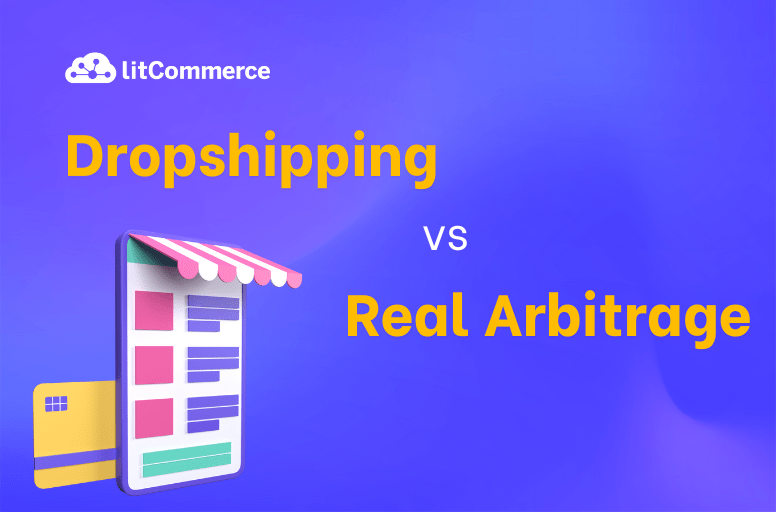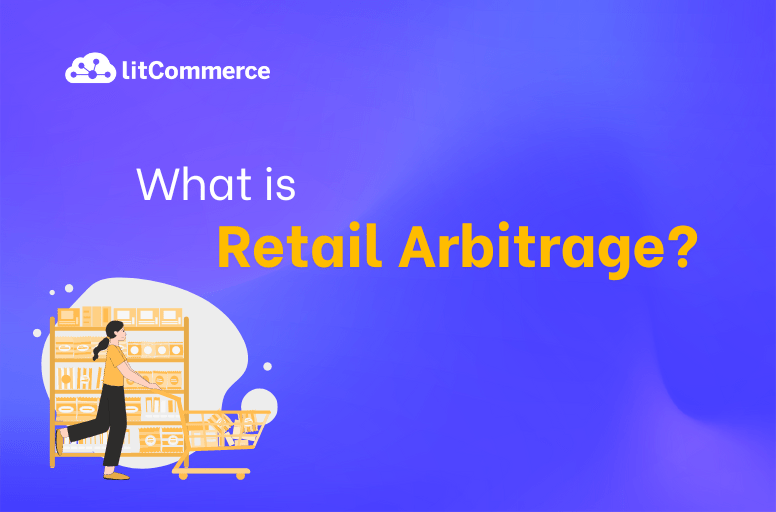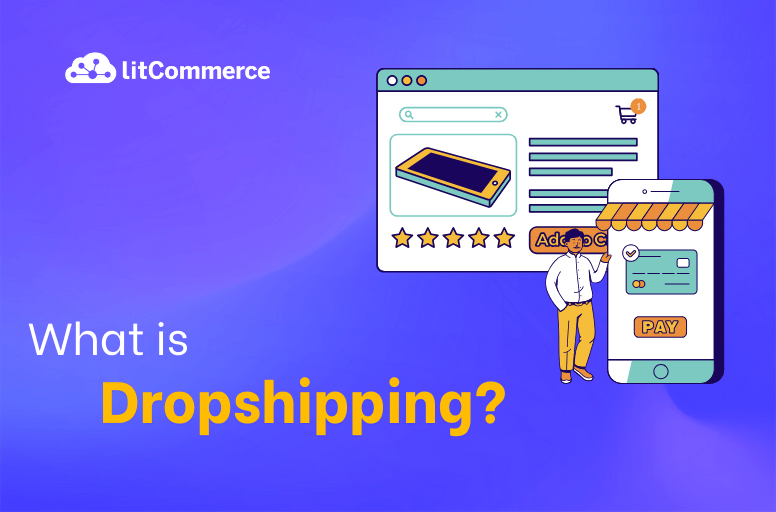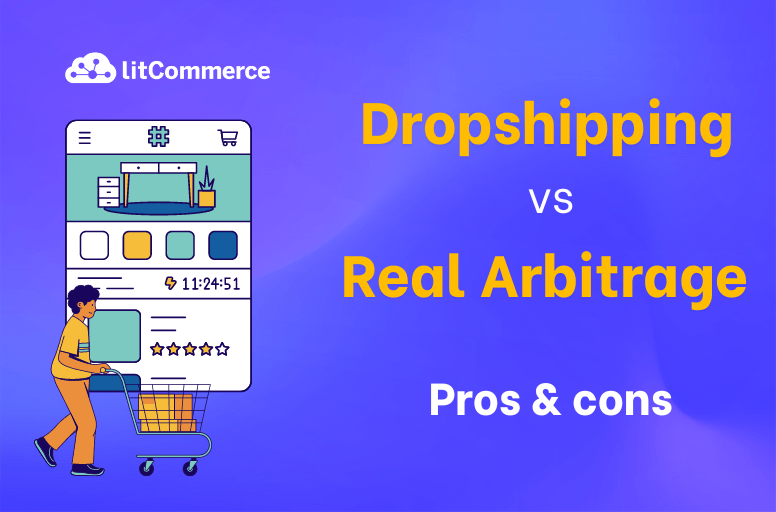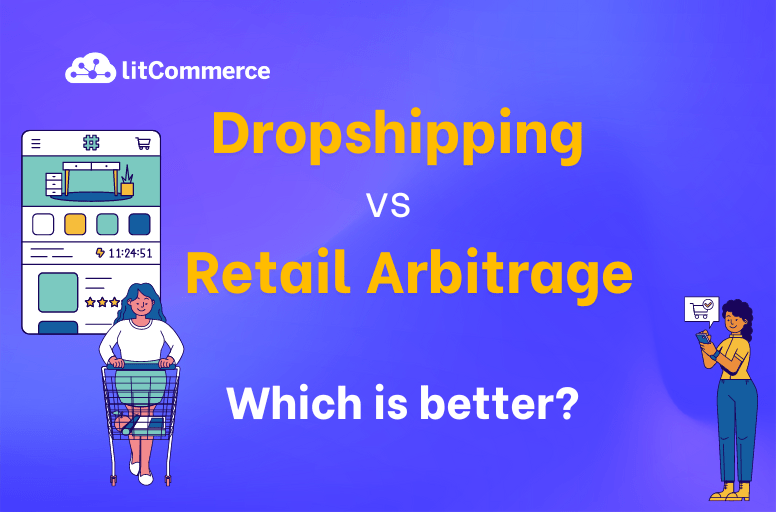Dropshipping and retail arbitrage offer two different ways to get started. We will take a deep dive into the comparison of dropshipping vs retail arbitrage from how each approach works, what their benefits are, what risks are involved in pursuing either option, and more.
So, start discovering the difference between arbitrage and dropshipping through these main sections right now:
- What is retail arbitrage on Amazon?
- What is dropshipping?
- Dropshipping vs Retail arbitrage – Pros and cons
- Expansion potential
- Wholesale dropshipping vs. Retail arbitrage: Which is better?
Dropshipping vs retail arbitrage
What Is Retail Arbitrage on Amazon?
Real arbitrage is a basic business strategy in which individuals acquire things at a reduced price from retail establishments and resell them for a profit on different websites such as Amazon or Walmart.
It entails making money by taking advantage of pricing disparities across markets. A common example is that you buy a shirt at Walmart for $10 and sell it on Amazon for the price of $25, which results in a substantial profit.
Along with traditional retail arbitrage on Amazon, there is also online arbitrage which is similar to the traditional one except you buy products online.
What is retail arbitrage?
Retail arbitrage is completely legal as long as the items you sell are in brand-new condition. This is based on the first-sale doctrine, once you purchase goods legally, you can resale them in an original condition.
However, it does not mean that you can resell everything on Amazon since some specific categories are “gated”. This implies that Amazon needs resellers to produce manufacturer or authorized distributors invoices.
After you have grasped the fundamentals of retail arbitrage, here’s an easy-to-follow instruction on how to get started.
- Create an Amazon seller account (if you do not have one): This will require some basic information about yourself, such as your name and address. You will also need to provide banking information for the account.
- Look for items you want to sell: You can use the tools to browse and search for items that you would like to sell. Check out both online stores and brick-and-mortar retailers for great deals.
- List items that you are going to sell and start selling: This process can be more involved than just posting a listing; you will need to provide details about the item such as its condition, category and estimated shipping weights.
- Choose fulfillment option: When you have listed the items for sale, you will then need to choose your fulfillment option.
- Access profit margins: This means that you can make more money on fewer sales as your prices are lower.
- Monitor reviews and manage your platform: As you are selling on Amazon, it is important to monitor reviews and manage your platform. Additionally, take note of any feedback so that you can make changes to improve your products or services if necessary.
By following these directions, you will be far along your way to begin your retail arbitrage career on Amazon.
What Is Dropshipping?
Dropshipping is known as a retail fulfillment strategy in which vendors sell their products on their online store without stocking them.
The process begins with a consumer placing an order, then the seller gets the item from a third-party supplier and sends it straight to the buyer.
This fulfillment approach is popular among entrepreneurs looking for efficiency and cheap expense, but it also comes at a cost, particularly when it relates to the experience of customers. Dropshipping businesses may find themselves competing on pricing, resulting in minimal profits.
What is dropshipping?
There are two ways you can implement a dropshipping strategy. The first option is to use a supplier database to find one or more wholesale suppliers. The second one is to use an app to connect with suppliers.
Once you know what dropshipping is, the following steps will help you know how to start dropshipping for free and create your successful dropshipping business.
- Select a business market niche: Determining which dropshipping products to sell and which markets to target.
- Make an arrangement with the dropshipper: This will take some time since you should choose a reliable provider who sells things in your niche.
- Create the brand identity: You can create a logo, name, or something else that is appropriate for your company and target demographic.
- Build and set up your online store: Select a host service and a platform for building your online store.
- Choose a right dropshipping app: This plays an important role in helping you find dropshipping products and suppliers.
- Promote your dropshipping business: Launching excellent promotion campaigns can help you boost your business and attract customers.
However, we note that the dropshipping strategy steps are not always the same since they can vary depending on your arrangement with suppliers.
Dropshipping vs Retail Arbitrage – Pros & Cons
We have thoroughly examined the two definitions of dropshipping and retail arbitrage, allowing us to draw a final judgment about the similarities and distinctions between dropshipping vs retail arbitrage. Here are comparable characteristics of these two models:
- Dropshipping and retail arbitrage both entail reselling products. The vendor does not need to market or advertise the goods.
- You do not need to spend neither time nor money when you first start. The initial expenditure is not too high for you to do a startup.
- When opposed to wholesale, both selling methods represent a smaller danger of suffering massive losses in a scenario of a sudden drop in demand.
- Your earnings are the variation between the vendor’s offered price and the price you decide for reselling.
However, these two selling models still have significant differences that you should consider when choosing dropshipping vs retail arbitrage.
- Retail arbitrage needs a large investment in space, shelves, etc. to maintain inventory. In contrast, dropshipping does not need any investment since third parties are responsible for handling order fulfillment tasks.
- Retail arbitrage may yield significant profits in a relatively short period of time. Dropshipping, on the other hand, does not make a lot of money at first but rises with time.
- Real arbitrage is riskier due to the fact that a reseller actually buys stuff to resell, whereas dropshipping entails less risk because a third party handles all order fulfillment activities.
Dropshipping vs Arbitrage – Pros and cons
To summarize what we said above, the below table will sum up the difference between retail arbitrage and dropshipping by their pros and cons.
[wptb id=65642]
Dropshipping vs retail arbitrage comparison table
Expansion potential
The expansion potential between wholesale dropshipping vs retail arbitrage is another factor to consider when deciding which model is best for you.
With retail arbitrage, it may be difficult to scale your business due to the limited supply of discounted products available in the market.
On the other hand, wholesale dropshipping offers more opportunities for scalability since you can easily add new product categories and increase your selection without incurring additional costs.
Wholesale dropshipping also gives you the ability to build a larger customer base. Since it allows you to offer a wider selection of products, you can appeal to more shoppers who are looking for particular items.
Plus, with dropshipping, your customers do not need to wait around for their orders, instead, they will receive their goods quickly and conveniently.
Finally, even though these two business models have quite similar purposes, both of them have their benefits and risks. Let’s go to the final answer, which is proper dropshipping vs arbitrage.
Wholesale Dropshipping vs. Retail Arbitrage: Which Is Better?
Until now, after learning everything about the difference between real arbitrage and dropshipping, you may wonder: “So, which is better?” or “Which should I choose?”. Our answer will be it depends.
Dropshipping vs retail arbitrage: Which is better?
When it comes to deciding between dropshipping vs retail arbitrage, there is no one-size-fits-all answer. Depending on your goals, budget, and resources, either option could be better for you.
Wholesale dropshipping allows you to offer a larger selection of goods while automating the order fulfillment process, whereas retail arbitrage enables you to take advantage of pricing discrepancies in the market and optimize profits with minimal upfront investment.
Ultimately, the decision between retail arbitrage vs dropshipping boils down to what you are looking for in a product-based business model. It is essential to do your research and weigh all of the pros and cons before making your decision.
By taking time to understand each approach and choose the one that best fits your goals, you can increase your chances of success and build a profitable product-based business.
Dropshipping vs Retail Arbitrage – FAQ
[sp_easyaccordion id=”65649″]
Dropshipping vs Retail Arbitrage – Final
Overall, whether you choose dropshipping vs retail arbitrage, both options present unique opportunities to generate income from physical products. With the right strategy, you can build a successful business no matter which model you pursue.
By leveraging the power of analytics in both dropshipping and retail arbitrage, you can identify customer trends and capitalize on high-demand products.
At the end of the day, make sure to stop by our LitCommerce Retail Blog and join our Facebook Community to stay up to date on the latest and most useful eCommerce news and advice! If you have any questions, feel free to Contact us!
